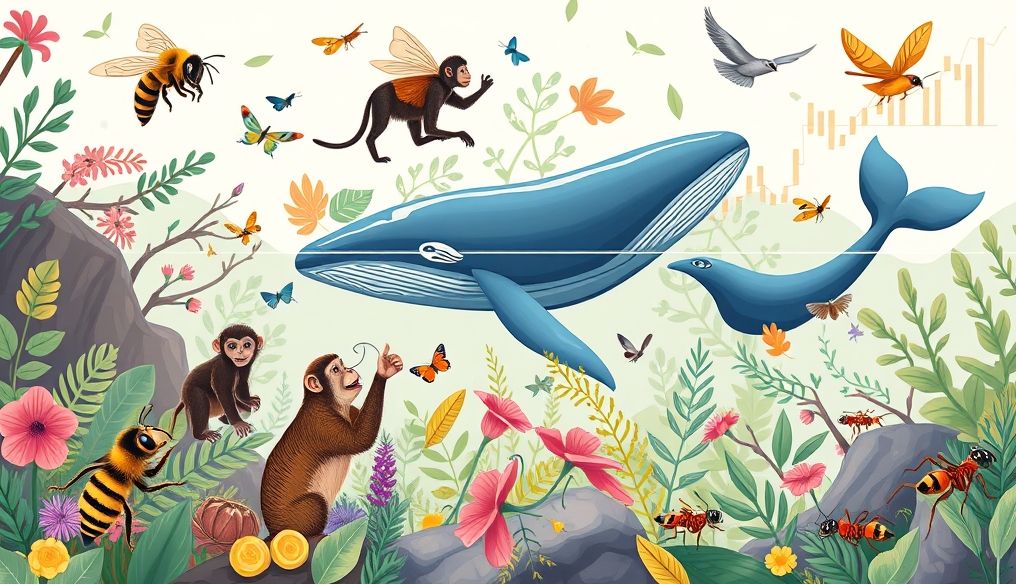Do Animals Communicate with Each Other in a Special Language, and What Forms Does This Communication Take?
The idea that animals communicate with each other in complex ways, perhaps even with a special language, has always fascinated us. While they may not have words and grammar as we understand them, they certainly possess sophisticated ways of expressing themselves and conveying information.
What is Animal Language?
Animal "language" should not be understood in the same way as human language. Instead, animal communication encompasses a wide range of signals, gestures, sounds, and scents that animals use to express emotions, intentions, or information.
Forms of Animal Communication:
- Vocal Communication: Such as dog barking, bird chirping, monkey screeching, and even snake hissing.
- Visual Communication: Such as body movements, facial expressions, feather displays, and color changes.
- Chemical Communication: Such as pheromones secreted by insects and other animals to attract mates or mark territories.
- Tactile Communication: Such as grooming, cuddling, and even light sparring that occurs between animals.
Examples of Complex Communication Among Animals
1. The Honeybee Dance:
The honeybee dance is a remarkable example of complex communication. When a scout bee returns to the hive after finding a food source, it performs a specific dance to tell the rest of the bees about the location and quality of that source. The dance includes information about the distance, direction, and even the amount of food available.
2. Monkey Warning Calls:
Some types of monkeys use different calls to warn of different types of predators. For example, they may have a specific call to warn of leopards, another call to warn of eagles, and a third call to warn of snakes. This allows the monkeys to respond appropriately to the specific threat.
3. Humpback Whale Song:
Humpback whales are known for their complex songs that can last for hours. Scientists believe that these songs are used to attract mates and compete with other males.
4. Pheromones in the Insect World:
Insects, such as ants, use pheromones to communicate with each other. Pheromones can indicate food trails, alert to danger, or attract mates.
The Importance of Animal Communication
Communication plays a vital role in the lives of animals. It allows them to:
- Find Food: By sharing information about food sources.
- Avoid Predators: By warning of danger.
- Mate and Reproduce: By attracting partners and competing with rivals.
- Maintain Social Order: By establishing hierarchies and avoiding conflicts.
- Raise Young: By teaching them essential survival skills.
Can We Understand Animal Language?
Although we may never be able to fully understand animal language, scientists are making significant progress in deciphering some of its aspects. By studying animal behavior, recording their sounds, and analyzing their chemical signals, we can gain valuable insights into their inner world.
Challenges in Studying Animal Communication
Studying animal communication is not an easy task. There are many challenges that scientists must overcome, including:
- Complexity: Animal communication can be very complex, with many different factors influencing it.
- Human Biases: We may tend to interpret animal behavior through a human lens, which can lead to inaccurate conclusions.
- Difficulty of Access: It can be difficult to study some animals in their natural environment.
- Environmental Changes: Environmental changes can affect animal behavior and communication methods.
Ethics of Studying Animal Communication
It is important to conduct animal communication studies in an ethical and responsible manner. Scientists must ensure that their studies do not cause any harm to the animals they are studying, and that they respect their natural rights.
The Future of Animal Communication Studies
As technology continues to advance, we can expect to see more exciting discoveries about animal communication in the future. We may one day be able to better understand the language of animals, which could open up a new world of knowledge and understanding.
Conclusion
Yes, animals communicate with each other in complex and diverse ways, using sounds, gestures, scents, and other signals. Although we may never be able to fully understand their language, studying animal communication can provide us with valuable insights into their inner world and their relationship with their environment.




